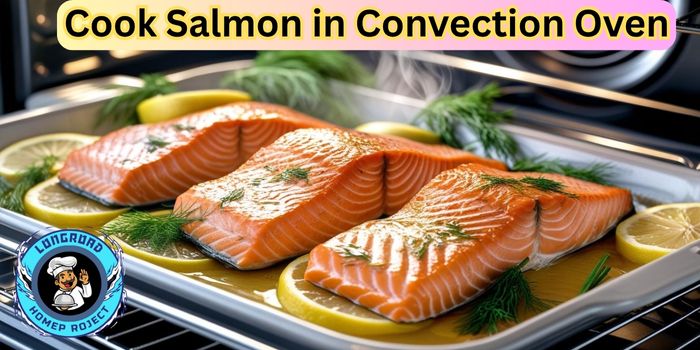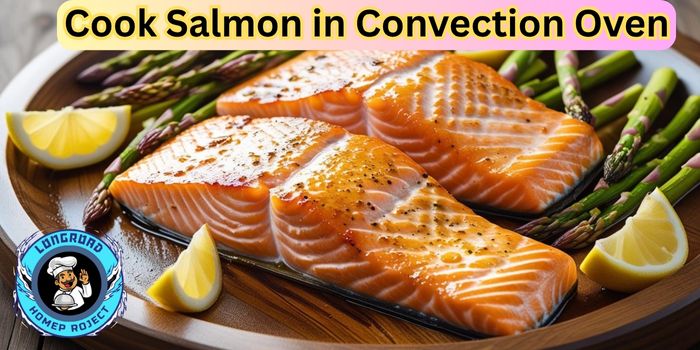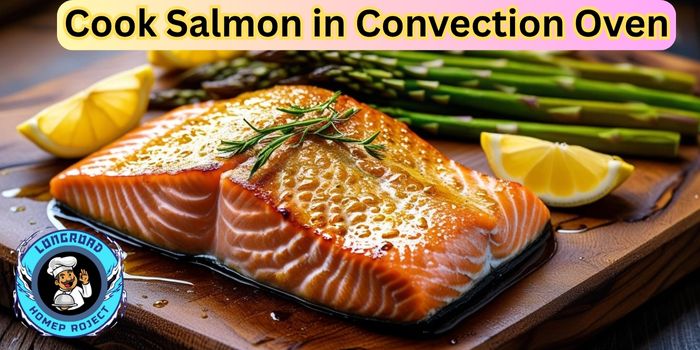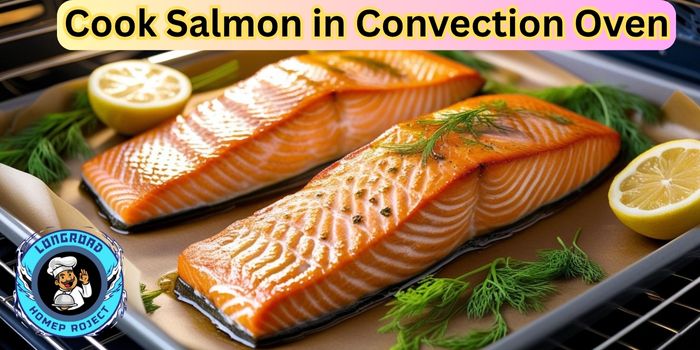As an Amazon Associate I earn from qualifying purchases.
Have you ever found yourself standing in your kitchen, salmon fillets in hand, wondering just how long they should be cooked in your convection oven? You’re not alone.
Cooking salmon to perfection can seem daunting, but it doesn’t have to be. Imagine serving a dish that’s not only mouth-wateringly delicious but also packed with nutrients, leaving you and your guests raving about your culinary skills. In this guide, you’ll discover the secrets to achieving that perfect balance—crispy on the outside, tender and juicy on the inside.
We’ll break down the cooking times and techniques you need to know to make your salmon the star of any meal. By the end of this article, you’ll be equipped with all the knowledge to cook salmon in your convection oven like a pro. So, are you ready to master this essential kitchen skill and impress everyone at your next dinner gathering? Let’s dive in!
Choosing The Right Salmon Cut
Cooking salmon in a convection oven is simple. Opt for fillets or steaks, as they cook evenly. Typically, bake at 375°F for about 12-15 minutes, depending on thickness.
Choosing the right salmon cut is crucial for achieving the perfect dish in your convection oven. It can be the difference between a melt-in-your-mouth experience and an overcooked disappointment. Knowing the specifics of each type of cut helps you cook your salmon to perfection, whether you’re a seasoned chef or a kitchen newbie.
Fillet Vs. Steak
Fillets are the most popular choice for many home cooks. They are thinner and cook faster, making them ideal if you’re short on time. The texture is often more delicate, and they tend to absorb marinades better. Steaks, on the other hand, are thicker and contain the bone. They offer a meatier bite and can be more forgiving in the oven, as they retain moisture better. Have you ever tried both and found one more satisfying in texture or flavor?
Fresh Vs. Frozen
Fresh salmon provides a vibrant taste and texture that is hard to beat. It’s easier to season and cooks evenly. Plus, there’s something rewarding about working with fresh ingredients. Remember to cook fresh salmon promptly for best results. Frozen salmon is convenient, especially if you plan meals ahead. It’s a great backup for busy nights or unexpected guests. Just ensure you defrost it properly before cooking to prevent uneven cooking. Have you considered keeping a stash in the freezer for a quick gourmet meal option? Choosing the right cut and knowing its nuances can elevate your salmon dish from mundane to memorable. What cut will you choose for your next culinary adventure?

Preparing Salmon For Cooking
Cooking salmon in a convection oven takes about 12-15 minutes at 400°F. This method ensures even cooking and a tender texture. Season the fillet with herbs or lemon for added flavor.
Cooking salmon in a convection oven can elevate your culinary skills, but before you pop it in the oven, preparing it correctly is essential. Fresh salmon offers endless possibilities, so why not make the most of it? Preparing it well ensures you get the perfect flavor and texture.
Seasoning Options
Choosing the right seasoning is crucial to enhancing salmon’s natural flavor. You can go simple with salt and pepper or add a twist with garlic powder and paprika. A lemon and dill combination offers a refreshing taste while a Cajun rub spices things up. Which seasoning will make your taste buds dance?
Marinating Techniques
Marinating salmon is a great way to infuse flavor and tenderize the fish. Try a soy sauce and honey marinade for a balance of sweet and savory. If you prefer citrus, a mix of orange juice, olive oil, and herbs can work wonders. The key is to marinate for at least 30 minutes. How does your ideal marinade look like? Remember, salmon is versatile, and your preparation choices can lead to a delectable meal. Whether you prefer bold flavors or subtle hints, the way you prepare your salmon sets the stage for an unforgettable dining experience. Are you ready to experiment and find your signature style?
Convection Oven Basics
Cooking salmon in a convection oven can elevate your culinary experience, but understanding the basics is crucial. Convection ovens use a fan to circulate hot air, ensuring even cooking and browning. This technique not only enhances the flavor but also speeds up cooking time, making it a favorite among home chefs.
Understanding Convection Cooking
Convection cooking is all about efficiency. The fan in the oven distributes heat evenly, preventing hot spots that can occur in conventional ovens. This means your salmon cooks consistently, with a beautifully crisp skin and tender flesh.
You might wonder how this affects your cooking strategy. Simply put, you can cook your salmon faster and at a lower temperature. This retains moisture and enhances the natural flavors. Have you ever had a dry fillet? Convection cooking can help you avoid that disappointment.
Benefits Of Convection Ovens
Why choose a convection oven? The benefits are compelling. First, the cooking time is reduced, which is perfect for those busy evenings. Imagine preparing a restaurant-quality meal in less time than it takes to watch your favorite TV show.
The even heat distribution also means fewer cooking mishaps. Whether you’re a seasoned chef or a beginner, a convection oven can be your trusted partner. Plus, the enhanced browning adds a professional touch to your dishes, impressing friends and family.
If you’ve ever struggled with uneven cooking or dry dishes, this oven might be your solution. It’s a game-changer in the kitchen, offering consistent results with minimal effort. Are you ready to transform your cooking experience?
Optimal Cooking Temperature
Salmon cooks perfectly in a convection oven at 400°F. Generally, bake it for about 12-15 minutes. Ensure the fish flakes easily with a fork.
Cooking salmon in a convection oven is a fantastic way to achieve a perfectly cooked dish with minimal effort. The key to success lies in understanding the optimal cooking temperature. This not only ensures that your salmon is deliciously flaky and moist but also retains its valuable nutrients. Let’s dive into the specifics to help you serve up a stunning salmon dish every time.
Temperature Recommendations
When cooking salmon in a convection oven, setting the right temperature can make all the difference. Aim for 375°F (190°C) for the best results. This temperature allows the salmon to cook evenly and develop a beautiful, slightly crisp exterior. If you’re short on time, you can increase the temperature to 400°F (204°C). However, be cautious as this might require you to keep a closer eye on your salmon to prevent overcooking. Just remember, patience often leads to the tastiest results!
Adjustments For Different Cuts
Not all salmon cuts are created equal. A thick fillet requires a bit more cooking time compared to a thinner piece. For thick cuts, consider cooking for about 12-15 minutes, while thinner cuts may only need around 8-10 minutes. Whole salmon might need a longer cooking time due to its size. Always use a meat thermometer to check if it’s done. You’re aiming for an internal temperature of 145°F (63°C) at the thickest part. Have you ever tried cooking salmon steaks in a convection oven? They’re perfect when you’re hosting a dinner party. Just remember to adjust the time based on thickness to impress your guests with perfectly cooked, juicy salmon. By knowing the optimal temperature and making small adjustments based on the cut, you can consistently achieve salmon that’s both delicious and healthful. What’s your favorite way to season salmon before popping it into the convection oven?
Cooking Time Guidelines
Cooking salmon in a convection oven takes about 12-15 minutes at 400°F. Aim for a juicy, tender texture by checking for opaque flesh and flaking easily with a fork. Adjust time based on thickness for perfect results.
Cooking salmon in a convection oven can be a delightful experience if you get the timing right. The convection oven uses a fan to circulate heat evenly, allowing your salmon to cook faster and more uniformly. But how long should you cook it to achieve that perfect flaky texture? Understanding the cooking time guidelines can elevate your culinary skills. Whether you’re preparing fillets or steaks, knowing the right cooking duration can make a difference between a moist, succulent dish and a dry disappointment.
Time Estimates For Fillets
Cooking salmon fillets in a convection oven is straightforward. Typically, fillets require less time compared to steaks due to their thinner profile. A general rule of thumb is to bake them at 375°F (190°C) for about 12-15 minutes. If you have a thick fillet, you might need to extend the time by a couple of minutes. Always check the internal temperature; it should reach 145°F (63°C) for safe consumption. Consider your fillet’s size and thickness. A thinner fillet might cook quicker, while a thicker one could take longer. Have you ever noticed how the edges cook faster? It’s because they’re exposed to direct heat more than the center.
Time Estimates For Steaks
Salmon steaks are heartier and thicker than fillets, requiring a bit more time in the convection oven. At 375°F (190°C), you should aim for 15-20 minutes. Monitor your steaks closely, especially if they’re particularly thick. You don’t want them drying out. Remember, the internal temperature should be the same as fillets—145°F (63°C). Think about how different it is to cook a steak versus a fillet. Each has its charm, but the steak offers a robust flavor that fillets sometimes lack. Ever wondered why chefs prefer steaks for more elaborate dishes? It’s all about that rich, flavorful experience. Have you tried different seasoning methods? A sprinkle of lemon pepper or a dollop of garlic butter can transform your salmon steaks from good to gourmet. It’s amazing how a simple twist can elevate your dish.

Checking Doneness
Cooking salmon in a convection oven can be a quick process. Ensuring your salmon is cooked perfectly involves checking its doneness. This helps achieve the right texture and taste. Let’s explore two effective ways to check if your salmon is ready.
Visual Indicators
Start by observing the color of the salmon. Perfectly cooked salmon should be opaque. It often transitions from bright pink to a paler shade. The edges may appear slightly golden. Look for flakiness. Insert a fork gently into the thickest part. The salmon should easily flake apart. This indicates it is cooked through. Avoid overcooking, which leads to dryness.
Using A Thermometer
A food thermometer provides accuracy. Insert it into the thickest part of the salmon. The ideal temperature is around 145°F (63°C). This ensures the salmon is safe to eat. Avoid guessing and risking undercooked fish. A thermometer takes away the guesswork. It gives you peace of mind. Make sure not to touch the pan with the thermometer. This affects the reading.
Serving Suggestions
Cooking salmon in a convection oven requires careful attention. Typically, bake at 400°F for 12-15 minutes. Check for flakiness before serving.
Cooking salmon in a convection oven is a delightful way to achieve a perfectly tender and flavorful dish. However, once your salmon is cooked to perfection, what comes next? Serving suggestions can elevate your meal from simple to extraordinary. Let’s explore some creative ideas to make your salmon dish the star of your dinner table.
Pairing With Side Dishes
Choosing the right side dish can enhance the flavors of your salmon. Consider a light quinoa salad with fresh herbs and lemon dressing. The citrus complements the richness of salmon beautifully. Steamed asparagus with a drizzle of olive oil and a pinch of sea salt is another excellent choice. The crisp texture and subtle flavor balance the buttery softness of the fish. If you prefer something hearty, try roasted sweet potatoes. Their natural sweetness pairs well with the savory notes of salmon, creating a harmonious balance on your plate.
Garnishing Tips
Garnishes can add both aesthetic appeal and flavor to your dish. Try adding a sprinkle of fresh dill or parsley to your cooked salmon. The herbs bring a fresh burst of flavor and a pop of color. A squeeze of lemon juice not only brightens the dish but also enhances the taste. Adding thin slices of lemon on top adds a decorative touch. For an unexpected twist, consider a dollop of homemade pesto sauce. The nutty and herbaceous flavors of pesto can turn your salmon into a gourmet masterpiece. How do you garnish your salmon? Experiment with different herbs and sauces to find your perfect combination.

Frequently Asked Questions
How Long To Bake Salmon At 350°f?
Baking salmon at 350°F in a convection oven takes about 12-15 minutes. The salmon should be opaque and flake easily with a fork. Always use a food thermometer to ensure the internal temperature reaches 145°F for safe consumption.
Should I Cover Salmon When Baking?
Covering salmon with foil helps it cook evenly and retain moisture. It prevents the fish from drying out. Uncovered salmon can also be baked for a crispier texture. Whether to cover depends on your texture preference.
What Temperature Is Best For Cooking Salmon?
The optimal temperature for cooking salmon in a convection oven is 350°F. This ensures the fish cooks evenly and retains its moisture. Always check the internal temperature reaches 145°F for safe consumption.
Can I Cook Frozen Salmon In The Oven?
Yes, you can cook frozen salmon in a convection oven. Preheat to 375°F and bake for about 25-30 minutes. Ensure the internal temperature reaches 145°F. Cooking time may vary based on thickness and size.
Conclusion
Cooking salmon in a convection oven is simple. Follow the right temperature and time. Your salmon will be tasty and healthy. It’s perfect for a quick dinner. Remember to check if it’s cooked through. This ensures the best flavor. Experiment with spices and herbs.
They can add a delicious twist. Enjoy your meal with family or friends. Cooking salmon doesn’t have to be hard. With practice, you’ll get it just right. Try different recipes to keep meals exciting. Cooking is fun and rewarding. So, get started today and enjoy delicious salmon!
As an Amazon Associate I earn from qualifying purchases.
